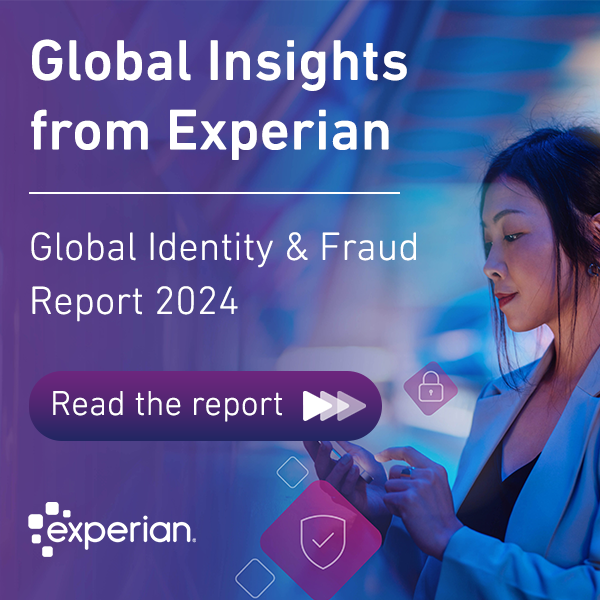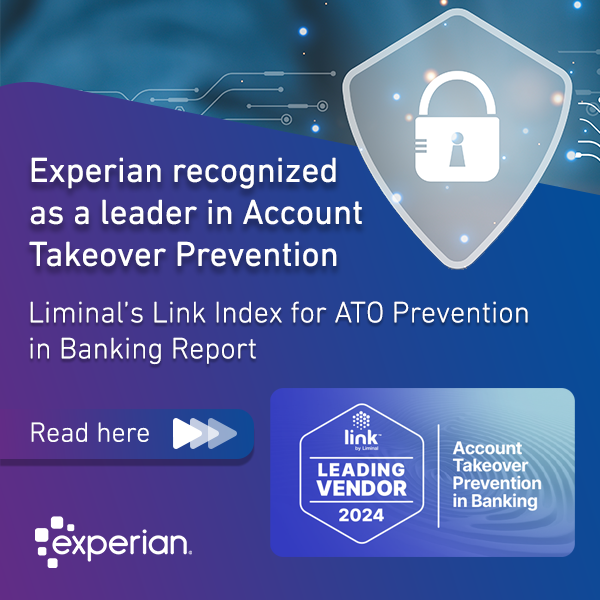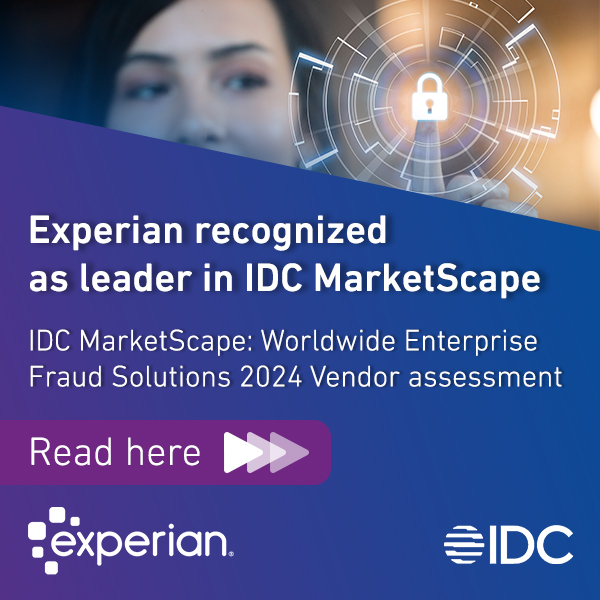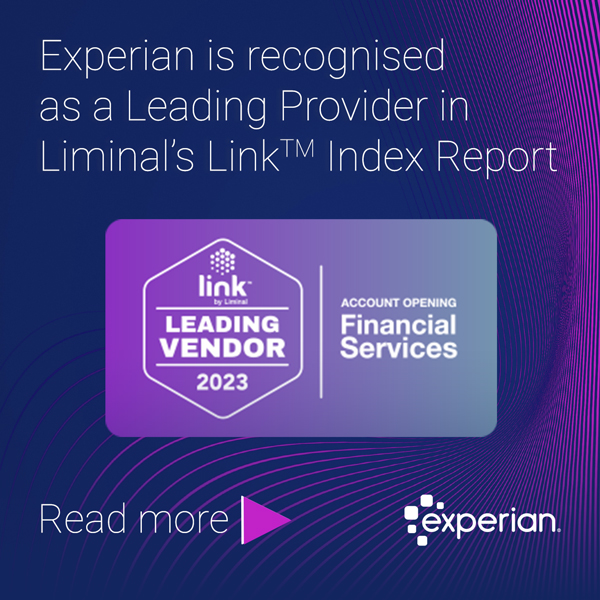Strategy & Operations
We look at the key business and operations challenges that keep business leaders moving forward.

Our latest Global Identity and Fraud Report reveals that fraud has been of high concern for consumers over the past year. In fact, more than half of consumers report that they are worried about online transactions, and 40% say that their concern has increased over this period. Data breaches, well-publicised scams, and direct first-hand experience with fraud have all contributed to these higher levels of concern. Our study shows that 77% of consumers had increased concern after experiencing online fraud, with more than half of consumers surveyed having had a close encounter with fraud: 58% of consumers say they have been a victim of online fraud, know someone who has been a victim, or both 57% of consumers say they have been a victim of identity theft, know someone who has been a victim, or both 53% of consumers say they have been a victim of account takeover, know someone who has been a victim, or both As a consequence, it makes sense that consumers rank security and privacy above convenience and personalisation when evaluating their online experience and expect businesses to take the necessary security steps to protect them online. We look at the main factors that play a role in the high levels of fraud concern among consumers and what businesses should do to address challenges in their fraud strategies. Three contributing factors to increased fraud concern among consumers Identity fraud has increased Our research also unveils that identity theft has overtaken credit card theft as consumers’ biggest security worry across all age groups. Furthermore, a recent report from the UK showed that recorded cases of identity fraud have grown by 22% over the past year. Fraud prevention and security professionals have been trying to educate consumers for a long time on this topic. Stealing identity data and using it in multiple fraud schemes can be significantly more harmful than criminals having access to someone's credit card numbers, where transactions can be traced quickly and revoked or charged back. While many factors contributed to an increase in concern about identity theft, the most impactful over the past two years were the numerous cases of unemployment and benefits fraud. Multiple countries reported cases where criminals applied for loans in the name of genuine consumers or through synthetic identities, created by combining real stolen information with fake data. The cost of these scams is yet to be discovered, and it could take years to see their full effect, with fraud losses well into the billions (if not trillions) of dollars worldwide. Criminals can access stolen data and fraud tutorials beyond the dark web To commit many types of fraud, criminals need Personal Identifiable Information (PII) that is stolen through techniques such as hacking attacks, credential harvesting, credential stuffing, phishing, or other types of social engineering. For years the knowledge of how to do that, along with the stolen data available after a successful attack, was available mainly on cybercriminal forums accessed through the dark web. However, over the past year, it has become easier than ever to obtain not only PII data but also valuable information on how to bypass some of the security and fraud features in place for a certain institution. Criminals no longer need to go to the dark web to do that - it's available on platforms like Telegram, just a few clicks away, where other fraudsters are selling tutorials (often called 'Sauce') on how to commit fraud, as well as PII data (called 'Fullz') to achieve it. As a result, the entry level for those that want to commit fraud has been set lower than ever before - both in terms of skillset and accessibility. Phishing and scams are at all-time high Another contributing factor to the increase in consumer concern is the number of scams resulting in authorised push payment fraud, which totalled £583.2 million in the UK alone during 2021. Criminals continue to seek out consumer vulnerabilities and use a variety of tactics to apply pressure on their victims and convince them to transfer money out of their bank accounts. This could take many forms - from various types of impersonation scams, romance scams, and investment (fraud) opportunities, to scams related to utility bills and easy loan offers among other types. This wouldn't be possible without numerous phishing/smishing/vishing attempts and the amount of data available through data breaches. One other factor that helps criminals is the direct access to potential victims given by social media and the sheer volume of personal information available in the public domain. These types of scams sometimes get high publicity (and rightly so) which can also contribute to the increased level of concern among the public while also applying additional pressure on financial institutions to improve their fraud screening and transaction monitoring capabilities to protect consumers. How businesses can improve fraud screening capabilities and increase consumer trust To restore consumer trust, businesses need to look for ways to improve their capabilities both at account opening and login to prevent criminals from gaining easy access to their services. There are multiple ways to do that, from introducing online identity document verification or phone-centric identity verification capabilities at the account opening stage, to adding behavioural biometrics, device intelligence, or fraud data sharing capabilities during different stages of the customer journey. By introducing some of these capabilities businesses also can improve the digital customer journey for genuine consumers and increase trust. Online identity document verification and phone-centric identity verification solutions both offer pre-fill capabilities. These tools can streamline registration processes and thus contribute greatly to a positive consumer outlook of the company that offers them. While behavioural biometrics, device intelligence, and fraud data sharing tools are invisible to both fraudsters and genuine consumers creating a more frictionless experience. Businesses should look carefully at the fraud they are experiencing along with fraud trends shared by similar businesses. This should help inform whether to introduce new capabilities as part of the existing strategy. It's common that companies might need a mix of capabilities to mitigate fraud issues, with additional support from machine learning models to blend them into one cohesive output while limiting the number of false positives and building consumer trust. Stay in the know with our latest research and insights:

It's hard to imagine an individual customer volunteering to remember multiple online passwords for various online accounts. Yet, for most of internet history, passwords have served as the backbone of online security and recognition—and given fraudsters easier access to our personal and financial data. Fortunately, our recent report reveals that consumers and businesses are evolving how they think about online recognition and authentication. Passwords are no longer consumers' preferred method of online security. For the second year, they didn't even make the top three list of what consumers consider the safest recognition methods. Instead, consumers are increasingly open to a variety of recognition tools, from physical and behavioral biometrics to one-time passcodes. By providing recognition choices, companies can improve the customer experience, decrease fraud, and ultimately build even more brand trust. Consumers are moving beyond passwords, but what should come next? Around the world, consumer fraud concern is rising in tandem with fraud activity. More than half of consumers report that they're worried about fraudulent online transactions, and 40% say that their concern has grown over the past year. That's likely because online fraud has become a far too common experience. For instance, 58% of consumers say that they've been a victim of fraud or know someone who has been a victim, and 83% of consumers say online security is their top priority. The awareness has made consumers more interested—and more confident in—emerging online recognition tools. It seems that many are not only tired of passwords but also understand how easily passwords can be compromised. Those surveyed ranked physical biometrics, pin codes delivered to a mobile device, and behavioral biometrics as the safest recognition methods. Notably, consumer confidence in each of the top three methods has increased significantly since 2021. This confidence in advanced recognition tools spans generations. For instance, 90% of Baby Boomers rank physical biometrics as the most secure, and 82% of Gen Xers and 75% of Gen Z say the same. Meanwhile, 81% of Millennials say behavioral biometrics are the most secure. These survey results suggest that most consumers are aware of fraud risk and willing to explore technologies that make their online transactions safer. Why recognition choice leads to better business outcomes Amidst this environment of change, financial service companies have the opportunity to introduce advanced recognition methods. Consumers are showing their willingness to move beyond passwords. But which recognition method should financial service companies choose? Which one will win out over the others? There's no one right answer. Consumers rank physical biometrics, pin codes, and behavioral biometrics as their top three preferences; however, there is no runaway leader in the group. Which method consumers prefer depends on what they're prioritizing. For instance, consumers who want convenience prefer physical biometrics, while people who value security tend to like two-factor authentication. The ambiguity around preferences allows businesses to introduce choice to their customers. Companies can offer visible methods that give customers access to the newer recognition tools they're beginning to prefer. Meanwhile, continuing to layer invisible methods that strengthen the overall security profile and enhance the customer experience. A menu of recognition options speaks to customer sentiments toward emerging technologies and may engender more trust and loyalty to a brand. For example, our 2022 research shows that 59% of consumers say that use of artificial intelligence increases their trust in a company. The key is being transparent about the choiceson offer and the role they play in protecting customer accounts and data. For example, explaining that the data underpinning specific authentication methods never leaves the device can go a long way with customers who may have misguided assumptions or reservations about specific recognition tools. The orchestration imperative Implementing choice can help customers improve the perception—and reality—of their online security. But leveraging multiple recognition options can also help organizations to better fight fraud. Multiple options enhance understanding of the customer and enables data analysis that can more easily identify outliers. The numerous data points strengthen recognition efforts, which further reinforces trust. It's a virtuous cycle that improves the customer experience and benefits the business. However, implementing multiple recognition methods can be a costly endeavor. Whether using outside vendors or developing and maintaining tools in-house, businesses should be layering recognition tools in the most efficient (and affordable) way. This is where orchestration tools really help. Creating secure environments for customers and businesses will continue to be complicated. Fraudsters are only getting more creative, and mitigating their impact requires a complex web of solutions that stymies them at various points. By starting with an orchestration engine, businesses can launch and manage multiple recognition methods more elegantly, using each tool correctly and at the right point in the customer journey. This strategic approach creates a single point of access to fraud and identity solutions, giving a 360-degree view of customer identity and reducing friction across the customer lifecycle. The days of passwords as the primary recognition tool are waning. Today's consumers understand the benefit of advanced recognition methods and will use them to increase their security, convenience and privacy. Offer customers choices, and businesses can meet these evolving expectations and decrease fraud risk along the way. Stay in the know with our latest research and insights:

Online fraud has increased at unprecedented levels over the past two and half years, with numerous reports coming from all corners of the world to confirm that. From benefits and unemployment fraud to authorised push payment fraud, and more advanced scams such as synthetic identity fraud and deepfake fraud, cybercrime has been on the rise. Understandably, the increase in criminal activity has had a significant impact on financial services businesses, and it is little wonder that this has been reflected in our recent study: • 48% of businesses reported that fraud is a high concern, and 90% reported fraud as a mid-to-high concern • 70% of businesses said their concern about fraud has increased since last year • 80% of businesses said that fraud is often or always discussed within their organisations High levels of fraud have also raised consumer concern, and their expectations of the protection businesses should offer them. Nearly three-quarters of consumers said that they expect businesses to take the necessary security steps to protect them online. However, only 23% of respondents were very confident that companies were taking steps to secure them online. Businesses need to take additional steps to meet consumer demand, while also protecting their reputation and revenue streams. Businesses are investing in fraud prevention, so why isn’t it working? As a result of the rise in fraud during the pandemic, there has been an increase in spending related to fraud prevention tools and technology, with 89% of businesses surveyed in our latest research indicating that investment in fraud detection software is important to them. However, there is a risk that institutions could take a siloed approach, and funds could be spent on point solutions that solve one or two problems without adding the needed flexibility to fight multiple attack patterns. This gives fraudsters the opportunity to exploit these gaps. Orchestration and automation drive fraudsters away Criminals constantly evolve. They are not new to technology and have multiple attack patterns that they can rely on. They also share information between themselves at a higher rate and pace when compared with financial institutions, banks, and merchants. Fraudsters can learn how to bypass one or two features in an organisation’s fraud prevention strategy if they recognise weak spots or a vulnerability that they can take advantage of. However, when multiple fraud prevention tools and capabilities work harmoniously against them, the chances are higher that they will eventually be blocked or forced to move to a weaker place where they can exploit another system. Synchronizing multiple solutions together is the key to excellent fraud orchestration Fraud orchestration platforms give businesses the chance to layer multiple solutions together. However, taking a layered approach is not only about piling multiple point solutions but also about synchronizing them to achieve the best output possible. Every solution looks at different signals and has its own way of scoring the events, which is why they need to be governed into a workflow to achieve the desired results. This means that institutions can control and optimize the order in which various solutions or capabilities are called, as the output of one solution could result in a different check for a subsequent one or even the need to trigger another solution altogether. It also gives companies the ability to preserve their user journeys while answering different risks presented to them. Some businesses are seeking to build trust with customers but want to stay invisible to remove friction from their digital customer experience. This is where capabilities such as device intelligence, behavioural biometrics, or fraud data sharing could be added as an additional layer in the fraud prevention strategy. Those additional solutions may only be called 30 per cent of the time when there is a real need for an additional check. Excellent orchestration means that organisations can rely on multiple solutions while only calling the services they need, exactly when they need them. Building trust through a secure but convenient customer experience. Machine Learning should be the final layer to rule them all The results from our research revealed the top initiatives that businesses are leveraging to improve the digital customer journey with the top two being: • Improving customer decisioning with AI • New AI models to improve decisioning While our April 2022 Global Insight Report showed that consumers are becoming more comfortable with AI, with 59% saying they trust organisations that use AI. Fraud orchestration platforms allow companies to deploy unified decisioning by leveraging machine learning (ML) on top of multiple fraud prevention tools. This means they can rely on one cohesive output instead of looking at separate, sometimes contradictory results across various platforms and making subjective decisions. ML can also offer explainability by pointing out the attributes that contributed the most to a particular suggestion or decision. These could be attributes coming from a few different tools instead of one. This also means that operational teams, like fraud investigators, have a single view of activity, resulting in operational efficiency - removing the need to log in to different tools and look at multiple screens, views, and scores, while also enabling faster decisions. Stay in the know with our latest research and insights:

We surveyed 6,000 consumers and 2,000 businesses from 20 countries worldwide as part of our ongoing efforts to learn more about how, why, and where consumers interact with businesses online.

We surveyed 6,000 consumers and 2,000 businesses from 20 countries worldwide as part of our ongoing efforts to learn more about how, why, and where consumers interact with businesses online.

Experian’s latest research shows that the crisis of the past few years has yielded a new, savvier digital consumer. With the rapid move to online services amidst the pandemic, consumers worldwide adapted—and quickly. Fifty-three per cent of consumers say they have increased their online spending and transactions within the past three months, and 50% plan to increase it even more over the next few months. As online activity has surged, so too have consumer expectations for friction-free, secure transactions. More than 80% of consumers say a positive online experience makes them think more highly of the brand. And if businesses don't meet those expectations? Well, switching providers is only becoming easier . For financial service providers, the evolution of consumer behaviour presents both an opportunity and a challenge. It's never been more critical to ensure that digital experiences are convenient and frictionless. However, soon that will be the expectation and not the draw for new customers. Instead, finding unique ways to compete will be what separates the good from the great. Convenience versus risk In our latest survey, consumers ranked security, convenience, and ease of recognition as the top contributors to a positive online experience. All of these are vital components to providing a frictionless transaction. However, seamlessly logging in to a financial app, applying for credit, or managing a balance isn't yet the standard for every provider. Many traditional banks continue to play catch-up with digital upstarts, but consumers are becoming less tolerant of barriers to accessing services and products, with 23% saying that businesses aren’t meeting their expectations for digital experiences. This provides businesses with the opportunity to attract and retain new customers, especially those tired of manual account onboarding processes. For instance, leveraging emerging recognition tools adds to the convenience factor, limiting the time customers spend inputting data and streamlining the entire experience. But even as they continue to prioritise frictionless processes, businesses should be wary of sacrificing security or increasing their own risk. In our survey, 73% of consumers said that the onus is on businesses to protect them online. While they don't want security efforts that slow down their transactions, they expect the level of security to remain high nonetheless. On the business side, we've also seen providers creating friction-free options for lending—for example, in the Buy Now, Pay Later (BNPL) space—that enable consumers to access credit nearly immediately. But even with the convenience, there is still a need to manage affordability and ensure that these customers aren't introducing additional risk to credit models. Differentiate to retain customers: The growing role of rewards With all the innovation underway, a friction-free experience will become the standard. And it may already be so among digital-first businesses. This begs the question: If a secure, convenient experience is the norm for consumers, then how can businesses differentiate themselves? The next competitive differentiator will be how businesses reward customers for their loyalty. It's no longer enough to provide new customers with low-interest or no-interest credit on small purchases. Forward-looking financial services providers are getting far more creative with their rewards. For instance, businesses offering BNPL are enabling their customers to accumulate loyalty points for using the service with multiple retailers. Customers can then put those points to use as discounts on merchandise from the places they already love to shop. Data sharing and analytics play a significant role in this approach, allowing businesses to understand their customers' behaviours and personalise offers and rewards. Notably, our survey reveals that 83% of consumers say their awareness of how companies use their personal data for security, convenience, and personalisation has increased. Today's consumers are as digital as ever, and there's no going back. While friction-free may have been the differentiator before, it's rapidly becoming the standard. Going forward, financial services providers will need to find a new way to compete for savvy consumers who expect—and demand—secure, frictionless online experiences. Stay in the know with our latest research and insights:

According to our latest research, 53% of consumers surveyed said their online spending and transactions increased in the past three months, and this is set to continue. Online shopping has become the norm for many, but what does that mean for online fraud? As with any growing industry, the fraud associated with it is also growing and changing. We take a look at brushing scams and what businesses can do to get ahead of this type of criminal activity. What is a brushing scam? A little-known scam called brushing has increased in popularity across the globe as more consumers are purchasing online exclusively. An increase in eCommerce means consumers are relying on the reviews of previous customers when deciding what to buy or whom to buy from, increasing the number of reviews, including negative reviews that impact these businesses. Most online retailers or eCommerce sites have a rating system in which verified buyers can rate the product purchased or, in the case of third-party retailers, can rate the sellers. The better the rating, the higher the seller is listed in searches. Many of the ratings include the number of purchases in the rating factor. The more purchases, the higher the rating. A brushing scam is when someone is hired to write a favorable review for an online seller. To become a verified buyer, they order small-value items with lower shipping costs so that the cost to complete is meager. They purchase the item under someone else's name and address to become and then create a favorable review for the seller. When done multiple times, it brings up the seller's rating by increasing the number of items sold and the number of favorable ratings and then increases the chances that real buyers will purchase from the seller. Other variations of a brushing scam include sending items that were not ordered at all or even empty boxes and envelopes. The orders are used to boost third-party rating positions, which allow these sellers to be listed higher in the third-party search algorithm and ultimately placed their business/product in front of other customers wanting to buy that product. The implications of brushing scams on consumers and businesses This type of fraud is two-fold for the consumer. It leaves many victims confused because it doesn't feel like fraud, and the victims don't understand how it impacts shopping habits, which leads to little or no detection. On the surface, the scam seems harmless. However, at minimum, the receiver has had their name and address compromised and may have additional personally identifiable information compromised. As a result, additional fraud activity may occur with the stolen personally identifiable information. But it also has economic side effects. By fraudulently increasing the sales numbers on financial statements it effectively feeds false information on publicly traded company performance. In addition, the Federal Trade Commission, which protects consumers from any false marketing, sees fake reviews as a form of fraud to the consumer. Online third-party resellers have policies that prohibit sending unsolicited packages and false reviews. They will suspend or remove accounts found to be doing this activity and work with law enforcement when needed. The problem is that the third-party reseller often doesn't know when it is happening, and many brushing scams go on unreported. What businesses should do to prevent brushing scams Businesses at risk of brushing scams, such as third-party resellers, should have a risk strategy that proactively searches for suspicious brushing activity. As with any fraud type, there is no one-size-fits-all solution and should include a layered approach that will detect the various known traits of how the fraud is carried out. Below are solution types to consider in a company's risk strategy. Device Intelligence Multiple orders/reviews are done from the same device with this trend. Using device intelligence to detect when the same device is used for multiple consumers of no relation can be an effective tool in identifying this type of scam. Email Intelligence Many fake user accounts are created with an email address that does not belong to the real person. Email intelligence solutions that can confirm the legitimacy of the email associated with the consumer can be another effective tool. Biometric Intelligence Detecting fraudsters from genuine users whether the interaction is human or automated, including bots, malware, or remote access tool by using the behavioral biometrics mouse movements, typing cadence, etc. Biometric intelligence is a proven tool in increasing the number of fraud transactions caught. Link Analysis A tool that detects additional accounts with the same details as accounts with confirmed fraud that may not have been alerted with another solution. While this is a hindsight tool, it can assist in uncovering trends. Machine Learning As this scam is evolving, the use of machine learning to detect the new patterns will be a highly effective tool for the large third-party resellers to detect emerging trends and keep operational costs reasonable, quickly and effectively. Machine learning is highly effective in reducing customer friction. As with any risk strategy, people within the organization should be made aware of the scam type and the internal reporting process. All customer reports should be taken seriously and reported to the proper investigation team. Stay in the know with our latest research and insights:

The ecosystem of credit lending platforms and technologies has rapidly grown in the past year. Lenders now find themselves in an increasingly competitive market with new players emerging on the scene. More companies now have access to advanced analytics and automation capabilities, and this is helping businesses improve the accuracy and inclusivity of consumer lending decisions – a giant step toward achieving their growth ambitions. Our recent research shows that one of the top priorities for businesses has been to invest in new artificial intelligence and machine learning models for smarter customer decisions. But how effective is building new AI models without considering the data? What is data-centric AI? Building AI models on fixed data has already become an outdated approach. But by coupling data with the best model, better outcomes can be achieved. The concept of data-centric AI was coined by leading thinker in the AI space, Andrew Ng. Ng believed that models in production are only as good as the point-in-time data used to build them. As businesses continue to receive new data, this data needs to feed back into the model if it’s going to continue delivering the best results. This continuous loop of enriching the model with new data can be applied across use cases. The value of data-centric AI models for acquiring new customers By using the latest available data, rather than from 6-12 months ago or longer when the model was originally developed, data-centric AI models can: • More rapidly account for changes in the economy and consumer finances • Reach under-represented populations and provide greater access to credit • Take advantage of newly available types of information from data providers The value of data-centric AI in existing frameworks More observations AI is often limited by the data that was used to create the model. By using a more fluid open-source alternative, different data sets can be inputted to get more observations based on different characteristics and findings. For example, if a business wants to acquire a new type of customer, traditional AI would require a new model with new data sets to be in order to target this new customer. With data-centric AI, businesses can use an existing model and simply expand the data, thus allowing the model to work far more efficiently and target a new consumer base. It is a shared view that businesses should not build models with just their own data, because those data sources are too limited. At the very least, businesses want to combine data with a peer sample. However, an even better way is to use hybrid data sets in order to get the most observations. Data-centric AI makes that process easy without the need to create different models to see different outcomes. Up-to-date data The world is in a state of flux—populations change, people change. This means that the data pools AI models draw on may be compromised, no longer relevant, or have new meaning over time. It’s important to keep AI data sets recent and up to date, and not assume that the models used two years ago still apply today. For AI models to operate efficiently they need current, relevant data. Having a data-centric approach and sweeping through collected observations is essential for any business relying on their AI solutions. Businesses must have processes to understand and test their data to be sure the values are still adding up to what they should be. Being disciplined about data hygiene, all the way back to the source, is a necessity. Enriched and expanded data With model-centric AI, businesses are limited by the data they start with. Data-centric AI makes it possible to expand on the current customer base, which already includes data on customer attributes, with new potential customers that might mimic characteristics of a business's current base. Expanded data can also play a role with financial inclusion and credit worthiness. Having a low credit score does not necessarily mean the consumer is a bad risk or that they shouldn't be allowed access to credit—sometimes, it could mean there is simply a lack of data. Expanding data to include varied sources and adding it to current models without changing their structure, enables businesses to provide credit for individuals who may not have originally been accepted. This new approach in AI is creating solutions that are far more inclusive than previously possible. Data has massively expanded and is constantly evolving. By using data combined with advanced analytics, such as AI, there will be more sophistication in the observations that come from the data. This will allow businesses to better decide what data they choose to rely on while ensuring accuracy. By using expanded data sources, the outcomes of models are changed, leading to more inclusive models better fit for decision making and improving performance. "Models in production are only as good as the point-in-time data used to build them." Andrew Ng Infographic: Why data-centric AI leads to more accurate and inclusive decisions Stay in the know with our latest research and insights:

Global fraud predictions for 2022, plus a closer look at regional fraud trends. Stay in the know with our latest research and insights:

*Stats from Experian Global Insights Research Read related content The evolution of data: Unlocking the potential of data to transform our world Be more open: Results of the 2021 Open Banking survey - Experian Academy Full text: The future of consumer lending in a digital economy With the advanced technologies available today, businesses can access relevant data and deliver on customer expectations in their moment of need. As more people go online and use digital channels, your business must do more to create a seamless and secure experience. Online activity has increased by 25% globally Online retail sales saw 4 years of growth in 12 months Now online, consumers have high expectations for digital experience without sacrificing security, convenience, and privacy. 64% of consumers have abandoned an online transaction in the past 12 months Consumers, regardless of age, now prefer online banking and payments over in-person transactions The future of credit and fraud risk management is integrating data and technology seamlessly to put the customer at the centre of it all. 74% of businesses are adopting AI (2021), up from 69% the year before Businesses can embrace customer-centricity at scale through: Behavioural biometrics within a layered strategy of defence to make it easier to tackle fraud and maintain a seamless customer journey Open source data so businesses of all sizes can build a view of potential customers, minimise credit risk, and bring more people into mainstream financial services Advanced analytics, AI, and machine learning for real-time underwriting, fraud detection and a truly personalised service “The market is now driven by consumer demand for digital services. Those companies that are able to tailor the digital customer journey – so it reflects the best-in-class consumer experience – are the ones that will win.” – Steve Wagner, Managing Director of Global Decision Analytics

Steve Yin, SVP of Global Identity and Fraud Product Management, talks to Juniper Research about what it means to be recognised through Juniper Research's Future of Digital Awards for innovation in fraud detection and prevention. Watch the video to find out about: The shift in trends across fraud Impact of the increase in online traffic How those who are new to digital can be more susceptible to fraud New or expanding merchants Education for consumers on secure digital interactions What's new in fraud detection and prevention? Models to detect known types of attack vectors Predictive: new signals and awareness of emerging threats CrossCore platform capabilities Stay in the know with our latest research and insights:

Dr Mark D. Spiteri writes on the Forbes Technology Council about how Experian has embraced DevOps culture to not only improve internal IT processes, but also to reshape the mindset of product development teams. What is DevOps? DevOps is the hybrid of development operations - a combination of software development and IT operations that shortens the product lifecycle and delivers a higher quality operational performance, benefiting the company and customer alike. The shift towards a service-centric culture As tech businesses move away from on-premises, product-centric culture, they are seeking alternatives that enable a service-centric approach. DevOps helps to do this by expanding upon agile and lean software development principles that ultimately lead to a cultural shift towards SaaS. The goal is to improve efficiency and accelerate the distribution of product enhancements, but it's all in the integration of these new ways of working. "It’s not a question if DevOps can help your company upgrade its product cycle; it’s a question of how well you can implement it into your organization." Foundations of DevOps People: Small, autonomous teams with a focus on collaboration and achieving system-orientated outcomes. Processes: End-to-end agile, lean practices for rapid IT service delivery. Technology: Automation tools that make the complete flow and pipeline of development and testing repeatable and reliable. "Improving the DevOps process can make a sea of change across every part of your product’s lifecycle, and what’s most fascinating is that the most important elements do not require a huge IT investment." Read the full article Stay in the know with our latest research and insights:




